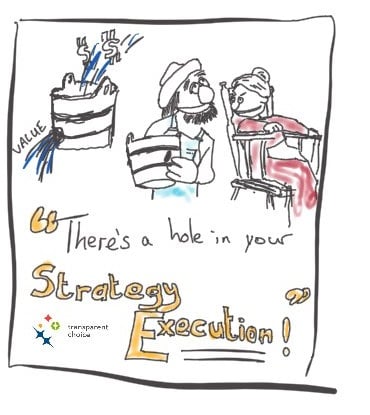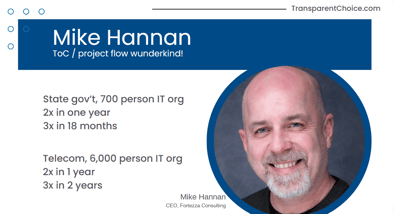Strategy Execution and Sesame Street
Updated:
Published:
 Executives: learn how to double the return from your investment in projects
Executives: learn how to double the return from your investment in projects
You're a senior exec. You’ve got the corner office. You have a bazillion people working for you. When you talk, people jump.
Life is good.
Except it’s not.
90% of executives fail to achieve their goals1. All those projects and initiatives that are how you execute your strategy never seem to “get you there”.
You keep pouring money and resources into the bucket marked “Project Execution”, but you never seem to get back the strategic impact that you want.
You’re beginning to believe that there must be a hole in that particular bucket!
A Hole in Your Bucket?
This is where we can learn something from Sesame Street. Specifically, the classic sketch where they sing the “Hole in the Bucket” song.
If you don’t know the song, here’s the gist.
A character called Liza asks Henry to fetch some water, but there’s a hole in the bucket so all the water leaks out. She tells him to fix it and he asks “With what shall I fix it…?”
The answer is “A stick”. It turns out that the stick (or straw in the Harry Belefonte / Odette version, which is the version I grew up listening to in 1970s England) is too big, so he needs a hatchet to cut the stick, but the hatchet is too blunt.
When Henry tries to sharpen the hatchet on a stone, the stone is too dry and so Liza tells him to fetch some water… in the bucket… but….
Yeah, there’s a hole in the bucket and the whole cycle starts again!
So, you just want the “project team” (usually the PMO, if you have one) to fix the hole in your bucket of projects by focusing on improving project management, but somehow, like in the song, you just keep going around in circles trying to patch the hole… but it never seems to get fixed. Round and round.
And all the time, money keeps going into the bucket, but the value just seems to leak away.
And here we come to the moral of the story… the reason you’re going round and round like Henry and Liza is that YOU’RE TRYING TO FIX THE WRONG HOLE.
Fix The Right Hole
Most organizations try to fix the “project management” hole. The logic goes like this.
Projects are going over budget, they’re late or they simply don’t deliver the intended benefit. Surely that’s a failure to manage the project properly. If we just focused even harder on project management, on training, on templates, on a new PPM tool, everything will get sorted, right?
That’s what you tell yourself. That’s what the PMO tells you. That’s what the “experts” say.
But the data tells a different story.
Executives around the world spend billions of Dollars a year on project management software, on training, on project management processes, but project success rates have barely moved.
Clearly, this is not the hole that needs fixing. Or rather, it's a hole that's already been fixed well enough.
But there's another hole, a much bigger hole, that is causing the problem; a hole that’s letting the value leak away.
So what is that hole?
The REAL Hole in Your Bucket
Well, the Project Management Institute did a study looking at the top performing project delivery organizations – the ones that deliver outstanding results (e.g. delivering the business benefit 92% of the time!). These organizations do the project management basics, sure, but they ALSO do portfolio management and governance well.
Now, if you're not a project management expert (and if you're a senior exec that's not your job) you are probably wondering what this “portfolio management” thing is.
Portfolio management and governance are all about the decision-making going on at the portfolio level. It’s about selecting the right projects, setting up your portfolio and your resources to increase the flow of projects, it’s ensuring the business realizes the benefits of the projects, etc.
And this stuff really matters. It could be the key to doubling the strategic return from your investment in projects (this video shows you how).
Unlock your Project Portfolio's true potential by fixing the real hole in your project bucket.
Double Your ROI?
Portfolio management and governance is a whole area of expertise. There are books, certifications, courses on the topic, but as with many things, there are some “quick wins” that you can put in place.
In portfolio management, the quick wins are;
- Reduce waste by putting in place a highly effective project prioritization process. The best way to do this, according to decision scientists, is with a method called AHP
- Reduce project overruns and failures by “right sizing your portfolio”. In other words, don’t overload your people. You should be aiming somewhere in the 80%-85% utilization rate. Anything beyond that drives up errors and slows down your execution.
- Don’t start all your projects at once. Staggering the start of your projects lets your team deliver value from projects earlier. It even helps them deliver more projects from the same resource.
- Review the balance of “keep the lights on” and “strategic” projects. In many organizations, this balance is skewed heavily to “keep the lights on”. If we could move a small amount of that investment to the “strategic” bucket it would have a massive effect.
When put together, we’ve seen examples where the business was able to double the strategic return on investment from their portfolio.
You can learn more about how to achieve this by watching the 6 minute video above.
Can I REALLY Double my ROI?

Doubling ROI is a bold claim. Some might say it’s not credible, but it absolutely is.
To illustrate the results that are possible, here are a couple of examples from one of our partners, Mike Hannan at Fortezza Consulting.
This is such a big claim that, if it were true, it could have a material impact on the overall performance of your business… so it has to be worth taking a look, right?
Well, we’ve created a great “first step” for you: our “Case for Change” workshop.
In this workshop, we will;
- Walk you through our "2x ROI" process
- See if your organization is a good candidate for 2x ROI
- Build a case for change for your leadership
- Co-present the case for change to help win support
So, what are you waiting for? That hole in the bucket won't fix itself!
Transform your portfolio and double your ROI—this bold claim is not just credible, it’s achievable.
Book a Case for Change now and transform your project outcomes by mastering portfolio management and governance.
1 www.brightline.org/resources/eiu-report/